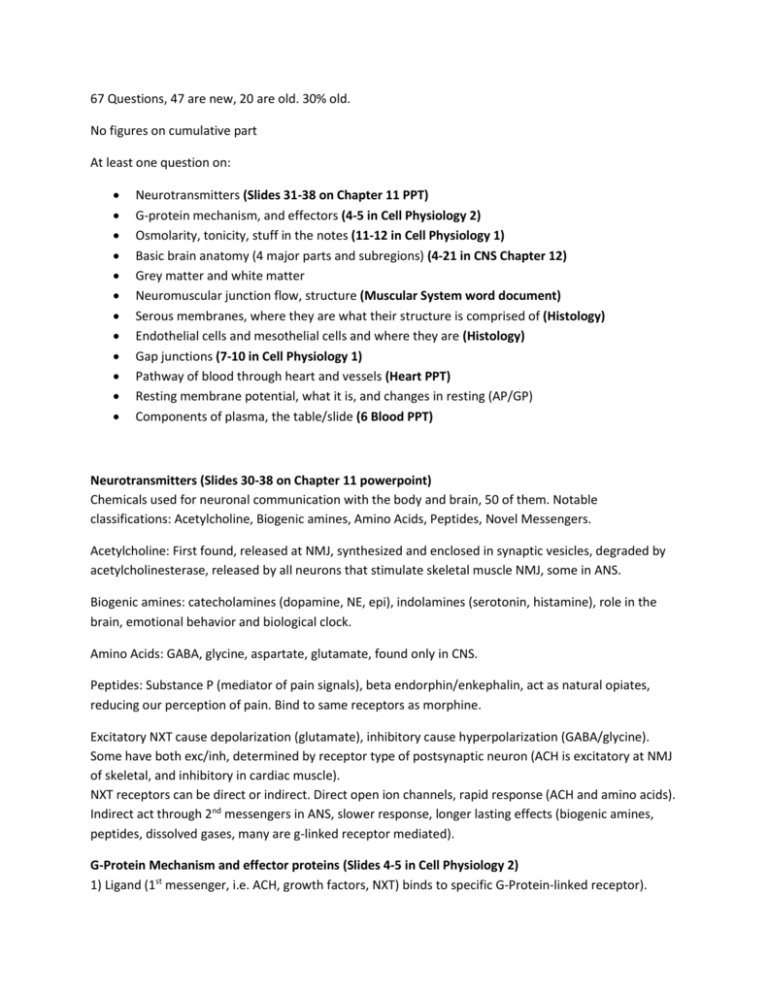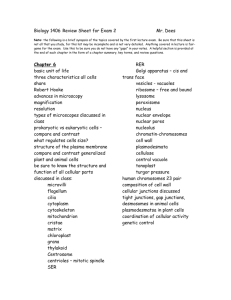File
advertisement

67 Questions, 47 are new, 20 are old. 30% old. No figures on cumulative part At least one question on: Neurotransmitters (Slides 31-38 on Chapter 11 PPT) G-protein mechanism, and effectors (4-5 in Cell Physiology 2) Osmolarity, tonicity, stuff in the notes (11-12 in Cell Physiology 1) Basic brain anatomy (4 major parts and subregions) (4-21 in CNS Chapter 12) Grey matter and white matter Neuromuscular junction flow, structure (Muscular System word document) Serous membranes, where they are what their structure is comprised of (Histology) Endothelial cells and mesothelial cells and where they are (Histology) Gap junctions (7-10 in Cell Physiology 1) Pathway of blood through heart and vessels (Heart PPT) Resting membrane potential, what it is, and changes in resting (AP/GP) Components of plasma, the table/slide (6 Blood PPT) Neurotransmitters (Slides 30-38 on Chapter 11 powerpoint) Chemicals used for neuronal communication with the body and brain, 50 of them. Notable classifications: Acetylcholine, Biogenic amines, Amino Acids, Peptides, Novel Messengers. Acetylcholine: First found, released at NMJ, synthesized and enclosed in synaptic vesicles, degraded by acetylcholinesterase, released by all neurons that stimulate skeletal muscle NMJ, some in ANS. Biogenic amines: catecholamines (dopamine, NE, epi), indolamines (serotonin, histamine), role in the brain, emotional behavior and biological clock. Amino Acids: GABA, glycine, aspartate, glutamate, found only in CNS. Peptides: Substance P (mediator of pain signals), beta endorphin/enkephalin, act as natural opiates, reducing our perception of pain. Bind to same receptors as morphine. Excitatory NXT cause depolarization (glutamate), inhibitory cause hyperpolarization (GABA/glycine). Some have both exc/inh, determined by receptor type of postsynaptic neuron (ACH is excitatory at NMJ of skeletal, and inhibitory in cardiac muscle). NXT receptors can be direct or indirect. Direct open ion channels, rapid response (ACH and amino acids). Indirect act through 2nd messengers in ANS, slower response, longer lasting effects (biogenic amines, peptides, dissolved gases, many are g-linked receptor mediated). G-Protein Mechanism and effector proteins (Slides 4-5 in Cell Physiology 2) 1) Ligand (1st messenger, i.e. ACH, growth factors, NXT) binds to specific G-Protein-linked receptor). 2) Receptor activates a G-Protein (GTP binds and GDP leaves) which causes 3) A relay of the message to effector protein (i.e. enzyme/ion channel: AC/PLC/K+/PDE) 4) Effector produces a 2nd messenger (cAMP, cGMP, IP3, DAG, Ca) inside the cell 5) 2nd messenger activates a kinase or ion channel 6) Kinase triggers cellular responses. Osmolarity/Tonicity (11-12 in Cell Physiology 1) Osmosis – diffusion of water across a semi-permable membrane. [Higher] [Lower]. A higher osmolarity solution has a lower [Water] and higher osmotic pressure, osmosis occurs until hydrostatic pressure equals the osmotic pressure. Osmolarity is the total concentration of solute particles in a solution. Most cells in body 300 mOsm. Isotonic – solutions with same solute concentration as that of cytosol, no change in cell shape. Hypertonic – solutions that have greater [Solute] than that of cytosol, cell shrinks. Hypotonic – solutions that have less [Solute] than that of cytosol, cell swells. Basic Brain Anatomy, Major Regions (4-21 in CHS Chapter 12) Cerebral Hemispheres: 83% of brain mass, contains ridges (gyri), shallow grooves (sulci), and deep grooves (large sulcus). 3 basic regions: cortex, white matter, basal nuclei (ganglia). Cortex: gray matter (40% of brain mass). Sensation, communication, memory, understanding, voluntary movements. Hemisphere controls opposite side of body, not equal in function. No functional area acts alone, conscious behavior requires entire cortex. Cortex has three types of functional areas. Motor areas that control voluntary movement, sensory areas that operate conscious awareness of sensation, and association areas that integrate information. Left hemisphere controls language, math and logic. Right hemisphere controls visual-spatial skills, emotion, and artistic skills. White Matter: consists of myelinated fibers and tracts, responsible for communication between cortex and lower CNS. Three types: Commissures which connect areas between two hemispheres, association fibers which connect different parts of the same hemisphere, and projection fibers which connect hemispheres to lower brain or cord. Basal Nuclei: gray matter found within white matter (caudate, lentiform). Motor control of muscles, and regulates attention/cognition. (Huntington’s/Parkinson’s). Diencephalon: Thalamus/Hypothalamus/Epithalamus, contains third ventricle. Thalamus: projects and receives fibers from cortex. Acts as relay station for info entering brain. Role in mediating sensation, motor activities, cortical arousal, learning, and memory. Hypothalamus: regulates blood pressure, rate of heartbeat, GI motility, rate of breathing ,and over visceral activities. Perception of pleasure/fear/rage. Maintenance of normal body temperature, hugner, and regulates sleep cycle. Epithalamus: Most dorsal, has pineal gland, secretes melatonin. (sleep cycle and mood). Brain Stem: has midbrain, pons, and medulla oblongata. Controls autonomic behaviors necessary for survival such as heart rate and breathing. Pathways between high/low brain centers. Cerebellum: 11% of brain mass. Precise timing/appropriate patterns of skeletal muscle contraction, and coordinates movements. Activity occurs subconsciously. Neuromuscular Junction Site where release of Acetylcholine by a motor neuron stimulates muscle fiber contraction. Always excitatory in skeletal muscle. The motor end plate is a folded area of the sarcolemma at the NMJ that contains ACH receptors. ACH receptors are cation channels. 1) Electrical signal (Action Potential) in motor neuron travels to the axon terminal. 2) Ca2+ ions enter axon terminal, and 3) Stimulates ACH release from synaptic vesciles into the axon terminal 4) ACH diffuses through into synaptic clect and binds to ACH receptors on motor end plate 5) ACH binding allows Na+ entry into muscle fiber, and K+ out, which causes a change in membrane potential, causing a depolarization. 6) The voltage-sensitive Na+ channels open and 7) Leads to an action potential along the sarcolemma of muscle cell muscle contraction Serous Membranes Simple squamos epithelium with underlying loose CT, with double-walled “sacs” containing fluid, wet membranes. Found in the closed body cavities (Thorax/abdominal cavities). 3 types: Pleura (lines thoracic wall/lungs), Pericardium (encloses the heart), peritoneum ( lines abdominal cavity and visceral organs) Endothelium: Lines inside of blood vessels, heart, and lymphatic vessels. Mesothelium: lines ventral body cavity and organs, part of peritoneum. Gap Junctions Membrane junctions are specialized protein complexes present in the plasma membrane that help join cells together, or allow them to communicate. Gap junctions: channels (connexon) between cells that allow chemical substances to pass between the cells. Cells with functional gap junctions are communicating cells that work as a synchronized group. Molecules that pass through are usually ions, signaling molecules (cAMP, IP3), energy (ATP), or toxins. Gap junctions are not found in skeletal muscle, only cardiac and smooth. Pathway of blood through heart/muscles The general flow of blood, starting from the Vena Cavas Vena Cava Right atrium Right Ventricle Pulmonary Trunk Pulmonary arteries Lungs, blood gets oxygenated Pulmonary veins Left atrium Left Ventricle Aorta Major Arteries arterioles Capillaries (oxygenated blood goes into tissues) Venules Veins Vena Cava Heart beats about 100,000 times per day. Pumps about 5.5 L/min. Membrane Potential (AP/GP) (1 in Cell Physiology 2, Muscular System, 11/20/21 in Chapter 11) Membrane potential is the voltage across a membrane. A resting membrane potential is voltage across the membrane of a cell at rest. Results from Na+ and K+ concentration gradients across the membrane and their different permeabilities. Resting membrane potential is maintained by active transport of ions. Action potential is in skeletal muscles and most neurons. Electrical impulse generated by rapid influx of Na+ into cell, resulting in depolarization of membrane above a threshold level. Action Potential is a rapid reversal of membrane potential above a threshold level with a total amplitude of ~100 mV. AP’s are only generated by muscle cells and neurons. Do not decrease in strength over distance, and are principal means of neural communication. An AP in axon of neuron is called a nerve impulse. Electrical signals carried by dendrites are graded potentials. They are short-lived, local changes in membrane potential, can only travel over short distances. Decrease in intensity with distance. Magnitude varies directly with the strength of the stimulus. Sufficiently strong graded potentials can initiate action potentials. Blood Plasma Composition Plasma is made up of several components: 90% is water, 10% is solutes ~8% of the solutes are proteins: Globulins (transport proteins i.e. albumin, and antibodies i.e. immunoglobulins), Clotting proteins (fibrinogen), Other (enzymes, hormones). ~2% are other solutes: Metabolic wastes: urea, lactic acid, creatinine. Nutrients: glucose, amino acids, vitamins, lipids. Electrolytes: Na+, K+, Ca2+, Cl-, PO4-, bicarbonate. Respiratory Gases: O2, CO2.







